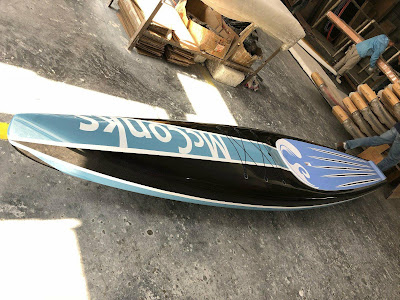 |
| McConks Carbon ready for shipping |
Random conversations and cheeky questions sometimes lead to good things. In September 2017 I was chatting to Andrew at McConks SUP and asked if he had any plans for a 14’ race board. McConks have a history with quality, no nonsense, good value inflatables and I was hoping that he had a plan to bring a longer, narrower and faster board to market. I was more than surprised when the reply was
“Inflatable or hard?”
Three little words that mean so much. Turns out that Lucy at Whitstable SUP had asked the same question and Andy was working on a 14’ carbon board, the first McConks hardboard. The plan was to make three prototypes and when I asked one had yet to find a home, a problem soon solved by my enthusiastic reply!
 |
| One of the early spec sheets |
The dimensions for the McConks prototype happened to be what I was looking for; a relatively wide, large volume board with a nose that would work well in chop and flatwater.
I’ve been lucky enough to own or paddle several race boards over the last few years, from classic K15s to brand new 14’ and 12’6” inflatable race boards and many in between. I currently have a 12’6” x 28” all water board and I had a very good idea of what I wanted from my first 14’ board so when Andy asked for any suggestions on the details I hit my keyboard with a wish list that Andy was kind enough not to throw away!
 |
| A later CAD design |
Several months later the three McConks Carbon boards are in a shipping container on their way to the UK. The time between that initial chat and the blanks being cut highlighted how easy it is to write a list and send it to someone to sort out but the extended conversations with Andy showed just how hard it is to design a SUP board, I was very glad that I wasn’t doing the hard work! CAD designs were tweaked, colours, graphics and logos added, repositioned and removed. Who’d have thought that a deck pad could be tricky but deck pad texture, graphics and positioning were tried ,discarded and done again. Ever had to think where a leash plug should go? Me neither but that’s a really important thing to sort out along with the vent plug, deck mounts and more.
Blanks cut and ready
The challenges in specifying the things that you don’t have to think about when buying off the shelf went on and on but Andy just dealt with them, occasionally asking a question or sending an image when he was happy. As an active spectator the process has been fascinating and it’s with some excitement that I’m now waiting for my McConks Carbon to arrive.
So what are the McConks Carbon dimensions and features;
14’ x 28” x 9” (max) / 339 litres / aprox 14 kg
Width
28”. That is enormous when you look at the current trend to go as narrow as possible, 21.5” for some stock race boards and narrower still for some custom boards. But something that narrow would be little more than a swimming aid for me and for many other paddlers and as a paddler that’s unlikely to be at the sharp end of a race a wide, more stable board makes sense leading to more time standing and paddling than swimming.
 |
| Freshly painted |
The Hull
Single concave down the centre. The aim is to channel water down the middle leading to increased stability and, if I can paddle well enough to keep the board on a plane, a bit more speed in a straight line.
The Tail
Slimmed down for buoy turns but keeping some width for stability when stepping back and turning.
Deck
The McConks deck is recessed but with no raised edge to trap water. My current 12’6” x 28” has a recessed deck which looks nice but collects water and has no drainage. That leaves me standing in a puddle all the time, not so bad in summer but less good in winter especially when the water freezes!
Deck Pad
Not too chunky with a kick pad at the tail for those who can get back that far and because kick pads look good on fast boards.
Fin Box
Full size US box. A relatively wide board is likely to be paddled by a larger paddler so it makes sense to have a fin box that will accommodate a big fin. That also has the advantage of allowing a fin with a smaller base to be positioned according to the course or for paddler preferences. Any extra drag from the gap in front of or behind a fin won’t be noticed by most paddlers.
Cargo
Typically ‘race’ boards don't have any consideration for carrying stuff, after all in a race who's going to willingly add weight to their board. But for most paddlers a race board has to do more than race and adding the capability to carry stuff when training or touring has to be a good thing with no downside in an event.
The only thing missing was from the photos from the factory is the big smiley face for the bow of mine and the board name but maybe Andy decided that printing “SUPpy McSUP Face” on one was a step too far. We’ll find out on 20.01.2018 when the three boards get wet for the first time, watch this space for details…




